Some form of hip flexor pain and/or back pain with total hip replacement seems to be a common experience among those of us with THR. I frequently get questions about it from students and I have read accounts from others with THR.
I remembered that several weeks after my second THR surgery I began to feel discomfort in my right groin. It was painful to raise my leg in flexion. I did some research and learned there are many reasons for hip flexor pain so with some sleuthing I began to understand what was happening in my body.
What are Hip Flexor muscles?
The iliopsoas muscle is the major flexor of your hip joint. It consists of three muscles: the iliacus , the psoas major, and the psoas minor. The three work together to flex your hip, and they also stabilize your hip and lower back during activities like yoga, dancing, walking, and standing up from a chair.
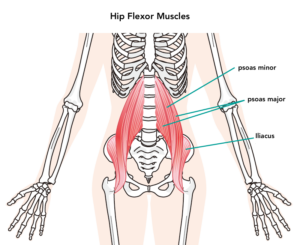
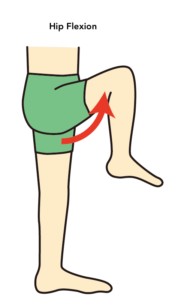
Functions of the Iliopsoas Muscles
In the physical body, The iliopsoas muscle helps maintain a healthy and balanced posture; it participates in almost every body movement. A tight iliopsoas can limit our freedom of movement when walking (and practicing yoga). A loose or damaged iliopsoas can contribute to instability.
In the emotional body, the psoas affects our ability to relax and influences our feelings of wellbeing and stability. A pliable, well-balanced psoas enables the flow of subtle energy and increases whole body sensitivity.
There are several reasons for pain related to the iliopsoas muscle and depending on the type of iliopsoas issue, the pain may show up in different locations, usually either the groin or the back.
Groin pain and iliopsoas and how it relates to Hip Flexor Pain
Ilipsoas tendinitis and iliopsoas bursitis: The two are almost interchangeable because of their close proximity to each other. They are characterized by hip flexor pain and pain in the groin.
Tendonitis or bursitis can occur because of the surgery itself. The surgeon has to manipulate your leg during surgery and this stretches the hip flexors and can cause strain and irritation. In addition, it is normal for the joint capsule to be inflamed after surgery and this tends to cause friction on the hip flexor tendon. Patience while healing and ice! ice! ice! is a good idea following surgery in order to help the healing process and to avoid hip flexor problems.
Muscles atrophy and shorten before and after the surgery due to lack of activity and so do tendons. As you return to your activities be aware that tendons, ligaments, and muscles build at different rates. Muscle strength can build within just a few days, while tendons and ligaments can take a few weeks before seeing improvement. If you have an aggressively ambitious yoga practice you may be getting your muscle strength ahead of your tendon strength and this puts extra stress on your tendons. Take it slow and easy as you return to your yoga practice or to other physical activities.
Iliopsoas injury (Psoas Syndrome)
Psoas Syndrome is caused by overuse of the hips or by injury. THR surgery can also traumatize the pos[a]s muscle. When you have an injured or strained muscle the best way to treat it at first is with rest and ice. When the acute phase of injury is past then you want to rejuvenate the muscle with strengthening postures like Plank Pose/Kumbhakasana, Boat Pose/Navasana, or gentle “peddling” on your back. Avoid deep stretches like Dancer Pose/Natarajasana or Pigeon Pose/Eka Pada Raja Kapotasana until you can move without pain.
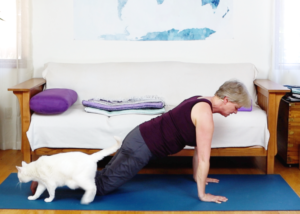
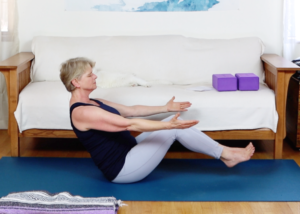
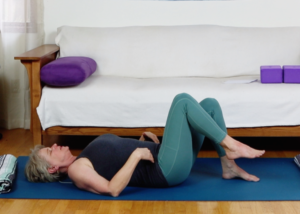
Symptoms of Psoas Syndrome:
Low back pain, stiffness or tightness
Pelvic pain
Hip pain
Groin pain
Buttock pain
Prosthesis Impingment:
“Iliopsoas impingement” can occur after total hip replacement. This is a condition where a portion of the prosthesis (usually the new cup) rubs on the iliopsoas tendon, causing pain and immflammation as well as limiting range of motion. Its frequency is very low (4.4%) but still it is something to be aware of if you are experiencing groin pain and limited motion. Your surgeon is the person to talk to about this condition.
Back Pain and Iliopsoas, How it relates to Hip Flexors
As mentioned above, the iliopsoas muscle can atrophy and shorten with the inactivity associated with THR. When this muscle shortens it can put undue stress on the low back by bringing it into an unnatural lordosis. The best way to “lengthen” this muscles is at first to warm it up with poses like Plank Pose/Kumbhakasana, Boat Pose/Navasana, or gentle “peddling” on your back. Then begin gentle stretching in poses like Warrior I/Virabhadrasana I or Locust pose/Salabasana. These poses require strength combined with stretching and are a safer way to start limbering the iliopsoas muscle.
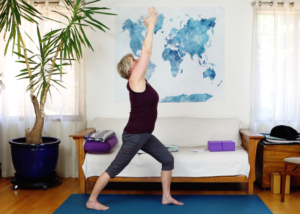
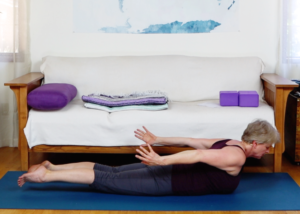
Remember this rule of thumb when approaching any strained or painful muscle:
First strengthen, then stretch!
Key Takeaways from Hip Flexor and Back Pain Post-THR:
- Iliopsoas Muscle: Vital for hip movement and lower back stability. Tight or weak iliopsoas can limit movement and cause instability.
- Causes of Pain: THR surgery can stretch or strain the iliopsoas, causing pain. Muscle atrophy and overactivity during recovery can also lead to discomfort.
- Psoas Syndrome: Caused by overuse or injury, resulting in groin, hip, and back pain. Early treatment includes rest, ice, and later, strengthening exercises.
- Iliopsoas Impingement: Rare, but occurs when the prosthesis rubs against the tendon. Consult your surgeon if you experience this.
- Back Pain: A shortened iliopsoas can affect posture, causing back pain. Gentle stretching and strengthening exercises can help.
- Recovery Tips: Strengthen first, then stretch. Gradually progress and consult with your healthcare provider before resuming physical activities.
Frequently Asked Questions
- What is the iliopsoas muscle and why is it important after a hip replacement?
The iliopsoas muscle is key for hip flexion and lower back stability. It helps with activities like walking, standing, and yoga. Post-surgery, its function is essential for movement, and any tightness or weakness can lead to discomfort. - How does total hip replacement (THR) affect the iliopsoas muscle?
During THR surgery, the iliopsoas muscle may be stretched or strained, leading to pain. Post-surgery inactivity can also cause muscle atrophy, affecting its flexibility and strength. - What are the symptoms of psoas syndrome after a hip replacement?
Symptoms of psoas syndrome include groin pain, low back stiffness, hip pain, pelvic pain, and buttock discomfort, often caused by overuse or strain of the iliopsoas muscle. - How can I relieve hip flexor pain after hip replacement surgery?
Start by resting and applying ice to reduce inflammation. As healing progresses, incorporate strengthening exercises like Plank Pose and Boat Pose to rejuvenate the muscle, avoiding deep stretches until pain subsides. - What is iliopsoas impingement and how does it relate to THR?
Iliopsoas impingement occurs when the prosthesis (usually the hip cup) rubs against the iliopsoas tendon, causing pain and inflammation. This is rare (about 4.4% of THR patients) but should be discussed with your surgeon if you experience groin pain and limited range of motion. - Why does back pain occur after THR and how can I address it?
Back pain can result from a shortened iliopsoas muscle that stresses the lower back. Gentle stretching and strengthening poses, like Warrior I or Locust Pose, can help alleviate this issue. - What should I do if my hip flexor pain persists after THR?
If pain persists, consult your surgeon or physical therapist. They may adjust your rehabilitation program or recommend alternative treatments. - Is it safe to practice yoga after hip replacement surgery?
Yes, but with caution. Start with gentle movements and avoid deep stretches until your body is ready. Gradually increase intensity under professional guidance to prevent further injury. - How long will it take to fully recover from hip flexor pain after THR?
Recovery time varies, but strengthening muscles and tendons can take several weeks. It’s essential to be patient and avoid rushing back into strenuous activities. - When can I return to my regular yoga practice after a hip replacement?
You can return to yoga once you have regained sufficient strength and flexibility in your hip and lower back muscles. Always consult with your doctor before resuming full yoga practices.
Here’s to Healthy and Happy Hips!
Member Videos: Standing poses with Hip Flexor Strength and Stretch, Twists, Hip Flexors & Hamstrings
Non-Member Preview: Yoga Basics, Standing Poses
Free video: Yoga while healing from Total Hip Replacement Surgery: A safe post-op asana practice
Become a member of Yoga for Hip Replacement here
Articles and Studies:
Blog: Healing from Total Hip Replacement and how yoga can help.
Iliopsoas tendonitis after total hip arthroplasty
Painful Hip Arthritis and Tight Hip Flexors
Emotional Release of the Psoas
The Importance of the Psoas Muscle
Art from : https://en.ac-illust.com

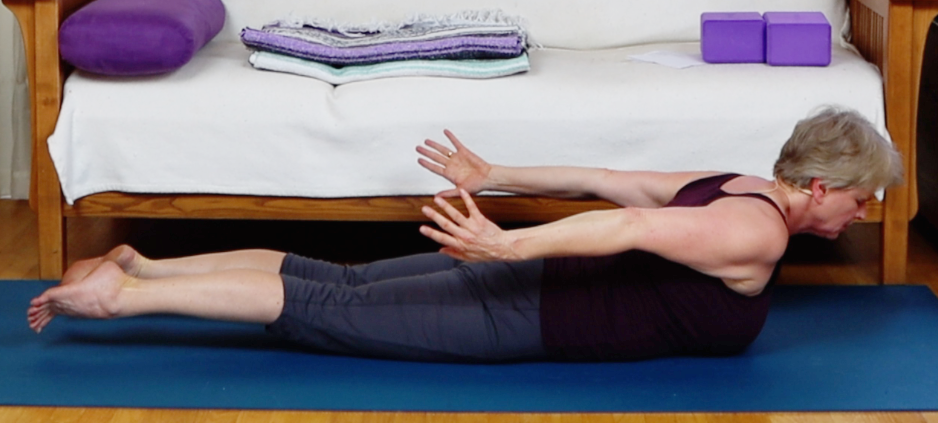
Thank you very much for your explanation. I had hip replacement surgery two weeks ago. In the first week after the surgery, to my surprise, I did not feel any pain while doing all the necessary exercises. On the eighth day, the physical therapist said that my muscles were strong enough to switch from a walker to a cane. However, starting from the second week, the pain appeared and increased every day. I have experience doing yoga. I try to relax each muscle during the exercises. Unfortunately, this helps only for a few minutes, then the pain returns and increases. My physical therapist does not know what is causing my pain. Your article helped me better understand what is happening in my hip joint. Thank you!!!
Hi Natalia, Thanks so much for your feedback. I am glad it was helpful! Best of luck with your new hip journey. ~E